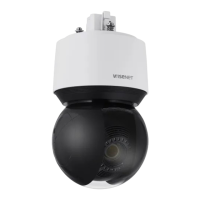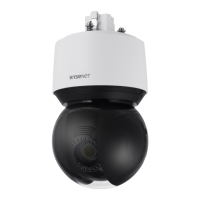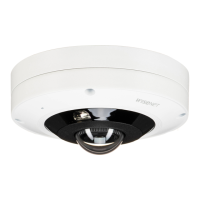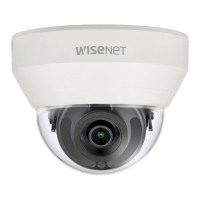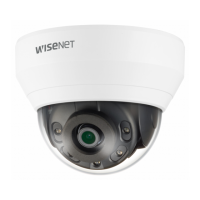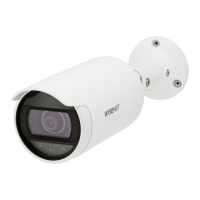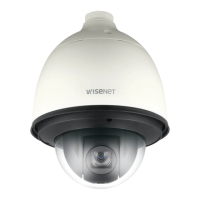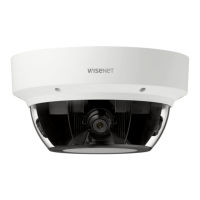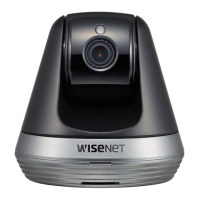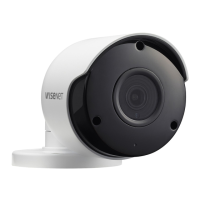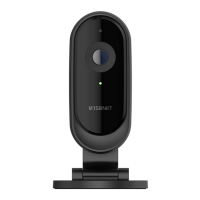How to record voice on Wisenet XNP-6120H?
- BBrian PerezAug 17, 2025
To record voice on your Wisenet Security Camera, you must enable the check box in - .
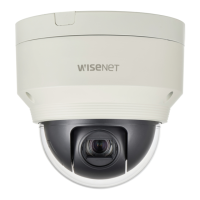
How to record voice on Wisenet XNP-6120H?
To record voice on your Wisenet Security Camera, you must enable the check box in - .
What to do if Wisenet XNP-6120H Security Camera reports that NAS setting has failed?
If your Wisenet Security Camera reports a failed NAS setting, take the following steps: First, make sure the NAS IP address is valid. Second, verify the NAS ID and password are correct. Third, confirm you can access the default folder using the NAS ID. Fourth, ensure NAS SMB/CIFS items are unchecked. Fifth, confirm the NAS and camera IP addresses are in the same format. Finally, check if you're trying to access as another user without formatting the default folder, and confirm you're using recommended NAS equipment.
Why does Wisenet Security Camera viewer get disconnected during monitoring?
A viewer might disconnect during monitoring on your Wisenet Security Camera if there are any changes to the camera or network configurations. Check all network connections to ensure they are stable. If the camera is connected over a PPPoE network, poor network conditions could also cause disconnections.
What to do if Wisenet XNP-6120H does not operate properly with Micro SD memory card?
If your Wisenet Security Camera isn't working correctly with a Micro SD card inserted, first check that the card is inserted in the correct direction. Note that the camera might not support memory cards formatted by other devices. If this is the case, format the memory card again in the camera's ? ? menu.
What to do if no video is displayed on Wisenet Security Camera plug-in free webviewer on Safari via HTTPS?
If you're not seeing video on the plug-in free webviewer on Safari via HTTPS for your Wisenet Security Camera, when the authentication popup window appears upon initial access, click "View Authentication Certificate" and select the "Always trust when connecting to the designated webviewer IP" check box. If the webviewer continues to fail, exit the Safari browser by pressing the command key + Q, then access again and repeat the steps above.
Why Wisenet Security Camera cannot record in the NAS?
If your Wisenet Security Camera cannot record to the NAS, confirm that the information registered in the NAS is correct.
What to do if Wisenet Security Camera cannot record into the Micro SD memory card?
If your Wisenet Security Camera cannot record into the Micro SD memory card, check if the memory card is defective.
Why does the microphone sound volume change periodically when accessing Wisenet XNP-6120H Security Camera web viewer on Windows 10?
If you're experiencing periodic changes in microphone sound volume when accessing the web viewer on Chrome or Firefox as a Windows 10 user, this occurs when the microphone driver is set to Realtek driver. Install the High Definition Audio device (Windows Default Driver) or a third party driver as the microphone driver.
Why do images overlap on my Wisenet Security Camera?
Images may overlap on your Wisenet Security Camera if two or more cameras are set to a single multicast address instead of different addresses. Check that each camera has a unique multicast address.
What to do if Wisenet Security Camera motion detection is enabled, but no notification e-mail is received?
If motion detection is enabled on your Wisenet Security Camera, but you're not receiving notification emails, first check the settings. Next, ensure is set to . Finally, verify the option in the menu is checked.
| Model | XNP-6120H |
|---|---|
| Sensor Type | 1/2.8" CMOS |
| Lens Type | Motorized Varifocal |
| Focal Length | 2.8 ~ 12 mm |
| Optical Zoom | 4x |
| Digital Zoom | 16x |
| Day/Night | Yes (ICR) |
| Video Compression | H.265, H.264, MJPEG |
| Ingress Protection | IP66 |
| Impact Protection | IK10 |
| Resolution | 1920x1080 (Full HD) |
| Minimum Illumination | 0.05 lux (Color), 0.01 lux (B/W) |
| Wide Dynamic Range (WDR) | 120dB |
| Audio | Line in/out |
| Network Interface | RJ45 10/100/1000Mbps |
| Power Input | PoE (802.3af) or 12V DC |
| Power Consumption | Max 15 W |
| Operating Temperature | -30°C ~ +60°C |
| Weight | 1.2kg |
Essential guidelines for safe operation and installation of the apparatus.
Crucial warnings about fire and electric shock risks, and proper installation.
Precautions regarding electrical shock and user-serviceable parts.
Explains the meaning of graphical symbols used in the manual for safety alerts.
Details on apparatus construction and electrical connection requirements.
Guidelines regarding battery safety, handling, and disposal precautions.
Instructions for safely disconnecting the main power plug from the apparatus.
Specifies the minimum computer requirements for using the camera software.
Lists recommended NAS products and capacity for optimal camera data storage.
Details recommended Micro SD/SDHC/SDXC card types and capacities.
Lists all the items provided in the camera package for installation and use.
Visual overview of the camera's external appearance and internal components.
Step-by-step guide for mounting and connecting the camera hardware.
Important safety and handling advice to follow before starting the installation process.
Instructions on how to carefully take apart the camera housing for access.
Detailed steps for connecting power, LAN, audio, RS-485, and alarm cables.
Information on purchasing and using various optional mounting accessories.
Guides for inserting, removing, and information on Micro SD cards.
Guidance on connecting the camera via Ethernet and Wi-Fi, including recommended dongles.
Information on camera power options, including DC 12V and PoE specifications.
Instructions for connecting audio devices like microphones and speakers to the camera.
Details on setting up RS-485 communication for PTZ control.
Instructions for connecting alarm input/output cables to the camera's I/O port box.
How to connect the camera directly to a local network or from a local PC.
Steps to connect the camera directly to a DHCP-enabled modem for network access.
Instructions for establishing a network connection using a PPPoE modem.
Steps to connect the camera to a broadband router for network access.
How to configure PC network settings for connecting to a broadband router.
Guide to using the Device Manager software for network configuration.
Methods for setting static and dynamic IP addresses using Device Manager.
Instructions for configuring port forwarding on a broadband router for remote access.
Procedures for accessing the camera from a local or remote PC via the internet.
Ways to access the camera via IP address, URL, or Bonjour protocol.
How to check and manage dynamic IP addresses using DDNS service.
Instructions for connecting to the camera using the UPnP protocol.
Guide to setting and managing the camera's administrator password for security.
Steps to log in to the camera's web viewer using user ID and password.
Details on plug-in compatibility and performance across different web browsers.
Instructions for downloading and installing the necessary web viewer plug-in.
How to view and control the camera video without installing plug-ins using specific browsers.
Explanation of the live view screen interface and its control elements.
Steps to search and play back recorded video from storage devices.
How to play recorded video files from Micro SD cards or NAS.
Configuring fundamental camera settings like video profiles, ATC, and system time.
Detailed guide to setting up video profiles, codecs, resolution, and bitrate.
How to manage user accounts, permissions, and guest access for the camera.
Procedures for setting the camera's time, timezone, and synchronization.
Setting IPv4/IPv6 addresses, ports, and DNS for network connectivity.
Configuring camera pan, tilt, zoom, focus, presets, and auto-run sequences.
Details on setting up RS-485 communication for PTZ control.
Configuring video settings like rotation, privacy zones, and audio input/output.
Adjusting camera parameters like image preset, exposure, and white balance for optimal imaging.
Settings for different image presets to optimize video quality in various conditions.
Configuring camera sensor parameters like framerate and mode.
Adjusting settings to improve image quality in challenging lighting or contrast conditions.
Optimizing image quality by adjusting backlight, highlight, wide dynamic range, and exposure.
Configuring noise reduction levels and day/night mode for clear video in varying light.
Advanced settings for DIS, sharpness, gamma, contrast, and defog.
Configuring DDNS, QoS, SNMP, and IP auto-configuration for network management.
Setting up Dynamic Domain Name Service for easy remote access.
Controlling access by creating lists of allowed or denied IP addresses.
Securing network connections with HTTPS and 802.1x authentication.
Configuring event detection, triggers, and actions like FTP/Email transfer.
Settings for recording video to Micro SD cards or NAS, including format and overwrite options.
Detailed instructions for saving data to a NAS, including setup and shared folder configuration.
Setting up camera alarm output types, modes, and duration.
Configuring alarm input types, activation times, and associated operations.
Scheduling image transmission at regular intervals based on time.
Configuring video analytics like motion detection, tampering detection, and face detection.
Configuring parameters for detecting motion within specified areas of the video feed.
Setting up the camera to detect physical tampering or unauthorized changes.
Configuring settings to detect and respond to fog conditions in the environment.
Setting up the camera to detect and respond to the presence of faces in the video feed.
Configuring advanced analytics rules for object detection and behavior analysis.
General settings to improve detection accuracy and minimize false positives.
Configuring automatic camera tracking based on object movement and environment.
Configuring settings to detect sound events and trigger actions.
Configuring settings to classify and respond to specific sound sources.
Managing product information, upgrades, restarts, and logs.
Viewing and updating camera model, serial number, and device details.
Procedures for upgrading firmware, resetting to factory defaults, and restarting the camera.
Common problems and their solutions for camera operation and connectivity issues.
Information on software licenses and terms used in the product.
